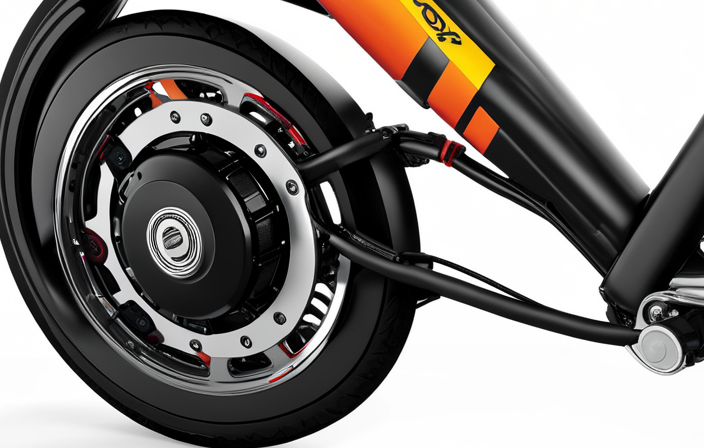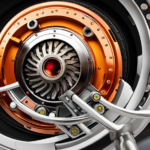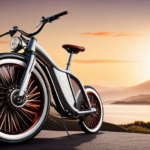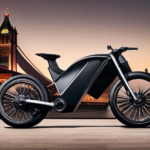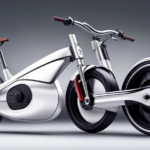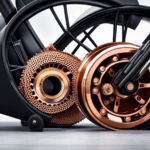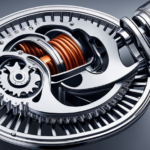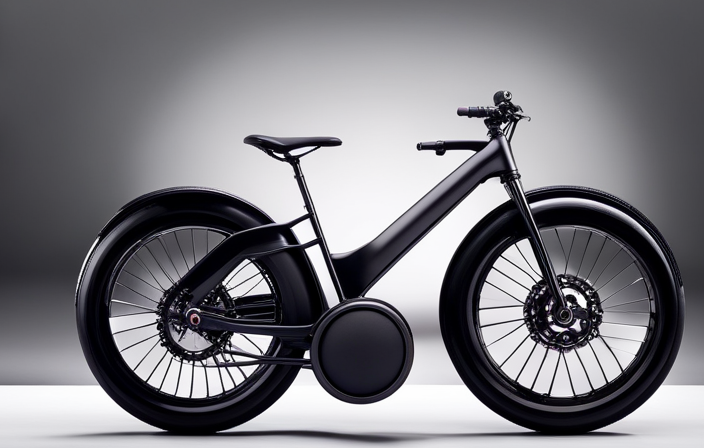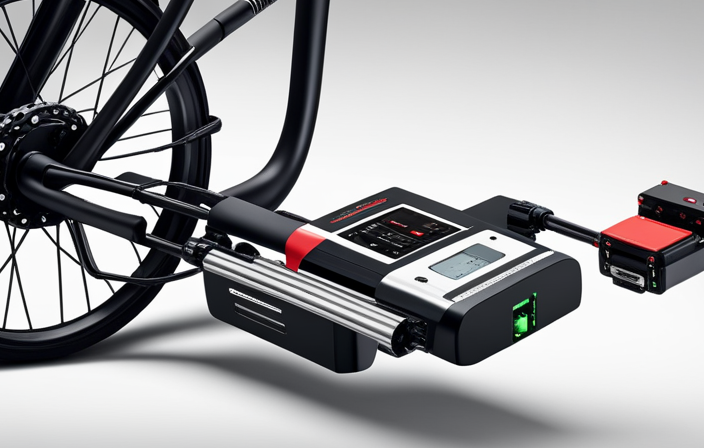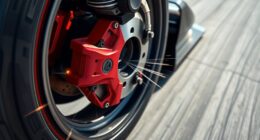Fuel your inquisitiveness as we explore the vibrant realm of electric bike motors. Have you ever been curious about the workings of these wonderful devices?
In this article, we’ll demystify the mechanics behind electric bike motor operation. From the components that make it tick to the power provided by the battery, we’ll explore it all.
So fasten your seatbelt and join me on this electrifying journey into the inner workings of electric bike motors. Let’s ride!
Key Takeaways
- Electric bike motors use gears for consistent speed with less effort.
- The motor acts as a generator when braking or coasting, converting energy back into electricity and storing it in the battery.
- Electric bike motors provide extended range for longer distances without running out of energy.
- Electric bike motors reduce carbon emissions and have zero emissions while in use, reducing carbon footprint.
Electric Bike Motor Basics
The electric bike motor works by using a battery to power a motor that assists with pedaling. When the rider starts pedaling, the motor kicks in and provides additional power to make pedaling easier. This is especially helpful when riding uphill or against strong winds.
The motor is controlled by a controller, which determines how much assistance is provided based on the rider’s input and the level of assistance selected. The motor is typically located near the pedals or in the rear wheel hub, and it is connected to the battery through a wiring system. The motor can provide different levels of assistance, allowing the rider to choose the desired level of support.
With the basics of how the electric bike motor works covered, let’s move on to the components of an electric bike motor.
Components of an Electric Bike Motor
To understand how an electric bike motor functions, you need to know about its different components. The motor is the heart of an electric bike and consists of three main parts: the stator, the rotor, and the controller.
The stator is a stationary component that houses the copper windings. These windings create a magnetic field when an electric current passes through them.
The rotor, on the other hand, is the rotating part of the motor and consists of magnets that interact with the stator’s magnetic field.
Finally, the controller acts as the brain of the motor, regulating the flow of electricity to control the speed and power output.
Understanding these components is crucial to comprehending how the battery provides power to the electric bike motor.
How Does the Battery Provide Power?
The battery provides power to the electric bike motor by supplying an electric current that interacts with the magnetic field created by the stator’s copper windings and the magnets on the rotor. This interaction causes the rotor to rotate, which in turn drives the bike’s wheels. The battery is typically located on the frame of the bike, and it stores electrical energy that is converted into mechanical energy to propel the bike forward. The battery’s capacity determines how far the bike can travel on a single charge, and it can be recharged by plugging it into a power source. Understanding how the battery provides power is important in comprehending the overall functioning of an electric bike. Transitioning to the next section, let’s delve into understanding the controller and its role in controlling the motor’s performance.
Understanding the Controller
Take a moment to understand how the controller functions and how it plays a crucial role in controlling the performance of the motor.
The controller acts as the brain of the electric bike, receiving signals from the throttle and sensors to determine how much power to deliver to the motor. It regulates the flow of electricity from the battery to the motor, ensuring a smooth and efficient ride.
The controller also monitors the motor’s speed and temperature, preventing it from overheating or operating beyond its limits. Additionally, it offers various modes and settings, allowing riders to customize the performance of their electric bike.
Now that we understand the controller’s role in controlling the motor’s performance, let’s delve into the next section about the role of the motor itself.
The Role of the Motor
Understanding how the controller functions helps in controlling the performance of the motor.
The motor is the heart of an electric bike, responsible for converting electrical energy into mechanical energy to propel the bike forward. It consists of several key components, including the stator, rotor, and magnets.
When an electric current is sent through the stator windings, it creates a magnetic field that interacts with the magnets on the rotor. This interaction causes the rotor to spin, generating torque that moves the bike.
The controller plays a crucial role in regulating the amount of current sent to the motor, controlling its speed and power output. By understanding the controller’s functions, we can better grasp how the motor works and its overall role in powering an electric bike.
How Does the Motor Work?
When discussing how the electric bike motor works, it’s important to understand the role of hall sensors, electric current, and magnetic fields.
Hall sensors are used in the motor to detect the position of the rotor and provide feedback to the controller.
Electric current is then sent through the motor windings, creating a magnetic field that interacts with the magnets on the rotor, causing it to spin.
Hall Sensors
To operate the electric bike motor, you’ll need to rely on the Hall sensors. These sensors play a crucial role in detecting the position of the motor’s rotor. They are placed strategically around the stator, which is the stationary part of the motor.
As the rotor moves, the Hall sensors can determine its position and send this information to the motor controller. This allows the controller to adjust the timing and power output accordingly. By constantly monitoring the rotor’s position, the Hall sensors ensure that the motor runs smoothly and efficiently.
Now, let’s dive into the next section where we’ll explore how electric current and magnetic fields come into play in powering the motor.
Electric Current and Magnetic Fields
To power your electric bike, you’ll need to grasp the concept of how electric current and magnetic fields interact.
When an electric current flows through a wire, it creates a magnetic field around it. This magnetic field can then interact with other magnetic fields to produce motion, which is how the electric bike motor works.
Inside the motor, there are magnets and coils of wire. The electric current passing through the coils creates a magnetic field that interacts with the magnets, causing them to move and generate rotational motion. This motion is then transferred to the bike’s wheels, enabling it to move forward.
Understanding this interaction between electric current and magnetic fields is crucial in comprehending the inner workings of an electric bike motor and its power assistance levels.
Power Assistance Levels
You can adjust the power assistance levels on an electric bike motor. It’s one of the great features that allows you to customize your riding experience.
The power assistance levels determine how much help the motor provides while you pedal. Here’s a breakdown of the different levels you can choose from:
- Eco: This level provides the least amount of assistance, perfect for conserving battery and getting a good workout.
- Normal: This level is a balanced option, offering a moderate level of assistance for everyday riding.
- Sport: This level increases the motor’s power, giving you a boost for faster speeds and tackling challenging terrains.
- Turbo: This level gives you the maximum assistance, allowing you to effortlessly conquer steep hills and ride at high speeds.
Adjusting the power assistance levels is as simple as pressing a button on the handlebar.
Now, let’s talk about regenerative braking and how it can further enhance your electric bike experience.
Regenerative Braking
Regenerative braking is an interesting feature of electric bikes that I’d like to discuss.
How does it work? Well, when you apply the brakes, the electric motor switches into reverse mode and acts as a generator, converting the kinetic energy of the bike into electrical energy. This energy is then stored in the battery for later use.
While regenerative braking can help recharge the battery and extend the bike’s range, it does have its limitations. For instance, it is not as efficient as traditional braking systems and may not work effectively at low speeds.
How Does It Work?
The electric bike motor uses a combination of electricity and mechanical components to provide power and assist with pedaling. When you start pedaling, a sensor detects the movement and sends a signal to the motor controller, which activates the motor.
The motor then provides additional power to help you pedal, making it easier to ride uphill or against strong winds. As you pedal, the motor spins a series of gears that turn the bike’s wheels. This allows you to maintain a consistent speed without exerting as much effort.
The motor also has regenerative braking capabilities, which means that when you brake or coast, the motor acts as a generator and converts the energy back into electricity, which is then stored in the battery for later use. This innovative design not only enhances the overall riding experience but also promotes energy efficiency.
Moving on to the benefits and limitations, the electric bike motor offers several advantages, such as extended range and reduced carbon emissions. However, it also has some limitations, including limited battery life and the need for occasional maintenance.
Benefits and Limitations
One of the benefits of an electric bike motor is its ability to provide extended range and reduced carbon emissions. With an electric motor, I can travel longer distances without worrying about running out of energy. It also allows me to reduce my carbon footprint, as electric bikes produce zero emissions while in use.
Another advantage is the convenience of charging the motor. I can simply plug it into a regular electrical outlet, making it easy to recharge wherever I am.
However, there are some limitations to consider. Electric bike motors can be expensive, and the initial investment may deter some potential buyers. Additionally, the range of an electric bike may be limited, depending on the capacity of the battery.
Despite these limitations, electric bike motors are a great option for eco-friendly transportation.
Moving on to maintenance and troubleshooting…
Maintenance and Troubleshooting
To keep your electric bike running smoothly, it’s important to regularly maintain and troubleshoot the motor. Here are four key maintenance and troubleshooting tips to ensure optimal performance:
-
Keep the motor clean: Regularly clean the motor and surrounding components to remove dirt and debris that can affect its efficiency.
-
Check battery connections: Ensure that the battery connections are secure and free from corrosion. Loose or corroded connections can lead to power issues.
-
Inspect and lubricate moving parts: Regularly inspect the motor’s moving parts and apply lubrication as needed. This helps reduce friction and prolong the motor’s lifespan.
-
Monitor for unusual noises or vibrations: Pay attention to any strange noises or vibrations coming from the motor. These can be signs of underlying issues that require immediate attention.
By following these maintenance and troubleshooting practices, you can keep your electric bike motor in top condition for a longer period.
Looking ahead, let’s explore the exciting future innovations in electric bike motors.
Future Innovations in Electric Bike Motors
Now that we’ve covered maintenance and troubleshooting for electric bike motors, let’s take a look at the exciting future innovations in this field.
As an enthusiast, I am thrilled to see how electric bike motors continue to evolve and improve. One exciting development is the integration of artificial intelligence (AI) technology into electric bike motors. This will allow the motor to adapt and learn from the rider’s behavior, providing a more personalized riding experience.
Another promising innovation is the use of regenerative braking systems, which will help conserve energy by capturing and storing the energy produced during braking.
Furthermore, advancements in battery technology will lead to lighter and more efficient electric bike motors.
With these future innovations, the possibilities for electric bike motors are endless, making the future of electric biking even more exciting.
Frequently Asked Questions
Can I use my electric bike motor in wet weather conditions?
Yes, you can use your electric bike motor in wet weather conditions. It is designed to be weather-resistant and can handle light rain or splashes. However, it is important to avoid submerging the motor in water to prevent damage.
How long does the battery of an electric bike motor typically last before needing replacement?
The battery of an electric bike motor typically lasts around 2-5 years before needing replacement, depending on usage and maintenance. Regular charging and avoiding extreme temperatures can help prolong its lifespan.
What are the safety measures to consider while using an electric bike motor?
When using an electric bike motor, it is important to consider safety measures. These include wearing a helmet, following traffic rules, using proper lighting and reflective gear, and maintaining a safe speed.
Can I upgrade the power output of my electric bike motor?
Yes, you can upgrade the power output of your electric bike motor. However, it is important to consult with a professional to ensure that the motor can handle the increased power and that proper safety measures are followed.
Are there any limitations or restrictions on where I can ride my electric bike with a motor?
Sure! There are a few limitations on where I can ride my electric bike with a motor, but they’re not too restrictive. As long as I stay off highways and respect local laws, the possibilities are almost endless!
Conclusion
In conclusion, electric bike motors are a fascinating and efficient technology that revolutionizes the way we ride. Every component, from the battery providing power to the controller controlling the motor, plays a crucial role. With power assistance levels and regenerative braking, electric bikes offer a seamless and enjoyable riding experience.
As the electric bike industry continues to grow, we can expect to see exciting innovations in the future. So remember, "Life is like riding an electric bike, it’s all about the journey, not just the destination!"
